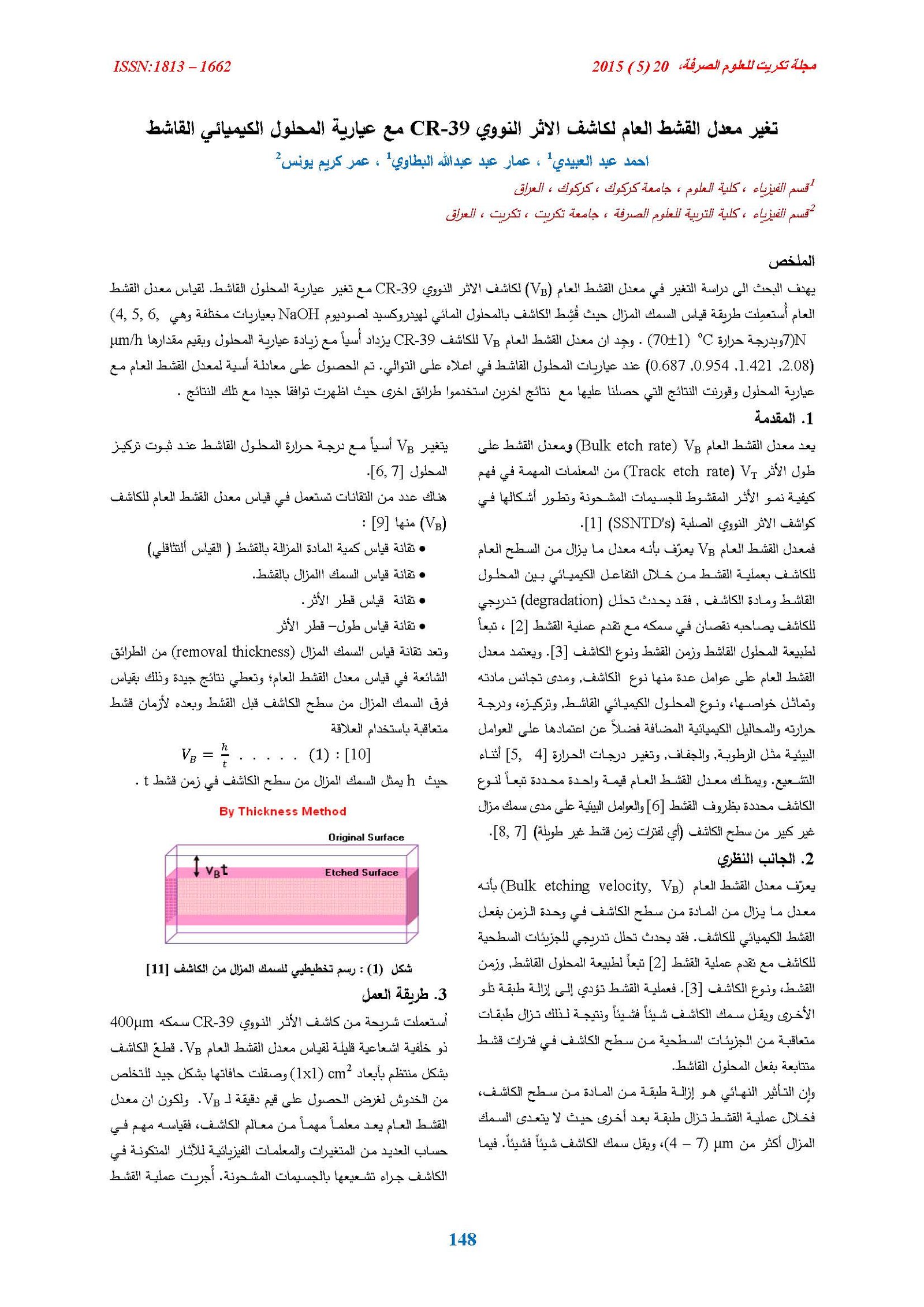Variation of the Bulk Etch Rate of Nuclear Track Detector CR-39 With the Chemical Etchant Solution Normality
Main Article Content
Abstract
The variation of the bulk etch rate (VB) of nuclear track detector CR-39 with the normality of the chemical etchant were studied. The removal thickness measurement method is used to determine the bulk etch rate. the detectors were etched by an aqueous solution of NaOH with normalities (4, 5, 6, 7) N at temperature (70±1) oC. It was found that the bulk etch rate is exponentially increasing with the normality of the solution and its values are (0.687, 1.421, 0.954, 2.082) µm/h at normalities (4, 5, 6, 7) N respectively. the relation between the bulk etch rate and the etchant normality was an exponential relation and the results showed good agreement with the results of the others used other normalities and another measurement method.
Article Details

This work is licensed under a Creative Commons Attribution 4.0 International License.
Tikrit Journal of Pure Science is licensed under the Creative Commons Attribution 4.0 International License, which allows users to copy, create extracts, abstracts, and new works from the article, alter and revise the article, and make commercial use of the article (including reuse and/or resale of the article by commercial entities), provided the user gives appropriate credit (with a link to the formal publication through the relevant DOI), provides a link to the license, indicates if changes were made, and the licensor is not represented as endorsing the use made of the work. The authors hold the copyright for their published work on the Tikrit J. Pure Sci. website, while Tikrit J. Pure Sci. is responsible for appreciate citation of their work, which is released under CC-BY-4.0, enabling the unrestricted use, distribution, and reproduction of an article in any medium, provided that the original work is properly cited.
References
[2] Nikezic, D. and Yu, K. N. (2004), "Formation and Growth of Tracks in Nuclear Track Materials", Materials Science and Engineers , R 46, pp. 51-123.
[3] Yip, C. W. Y., Ho, J. P. Y., Nikezic, D. and Yu, K. N. (2003), "Study of Inhomogeneity in Thickness of LR 115 Detector with SEM and Form Talysurf ". Radiat. Meas., 36, pp. 161-164.
[4] Ng F. M. F.; Nikezic, D. and Yu, K. N. (2005), "Measuring Depths of Sub-Micron in a CR-39 Detector from Replicas Using Atomic Force Microscopy", Radiat. Meas., 40, pp. 380-383.
[8] Szydlowski A., Sadowski M., Czyzewski T., Jaskola M., Kormona A., Kedzierski J. and Krestschmer W. (1999), "Investigation of response of CR-39, PM-355 and PM-500 types of nuclear track detectors to energetic carbon ions". Rad. Meas., 312: pp257-260.
ISSN:1813 – 1662 2015 ) 5( مجلة تكريت للعلوم الصرفة، 20
151
[10] Kocsis, Z. S.; Dwivedi, K. K. and Brandt, R. (1997), "Studies on the Track Formation Mechanism of the Heavy Ions in CR-39", Radiat. Meas., 28(1-6), pp.177-180.
[11] Manzoor, S. (2006), "Nuclear Track Detectors for Environmental Studies and Radiation Monitoring", Physical Department, University of Bologna. http://www.slac.stanford.edu/spires/find/hep/wwwauthors?key=6995985
